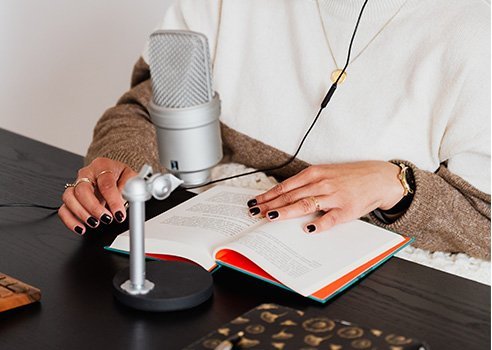Word count: 719 words
Reading time: Less than 3 minutes
Do you recite your writing ALOUD before submitting it? You should! Read on to learn why….
I grew up in a family that didn’t eat turkey for Christmas every year. My favourite holiday entrée? Fresh crab! We never wrapped gifts properly — in fact, we frequently deposited them in brown paper bags. And although both my grandmothers (who died before I was born) had been intensely musical, neither of my parents was, so we had little music. But there is one Christmas tradition I maintain to this day. Each year I listen to A Child’s Christmas in Wales by Dylan Thomas.
The Welsh poet’s voice — both crisp and sweet, like an apple — his gently rolling Ls and Rs and his euphonious Welsh tones combine with the exquisite beauty of his words to make A Child’s Christmas in Wales a language lesson — even if you don’t celebrate Christmas.
As I listened to it this year, I was reminded of why it’s so important for writers to read their own work out loud. True, you may not write like Dylan Thomas. And you almost certainly won’t sound like him. But, still, you should read.
I worked in a newsroom for six years. It was an open area office with perhaps 100 people. (Those were the days!) Even under such public conditions I read my work aloud, albeit whisperingly, along with the stories of all the reporters I edited. And I still do this today. Here are five questions I always ask myself:
1) How is the rhythm of the language? Writing isn’t just about words — it’s about the sound of them. When you read aloud your ear will reveal whether the words you chose — and the length of the sentences you created — are pleasing or harsh. Trust your ear. It has a far better sense of rhythm than your brain.
2) Does the text sound like the spoken word? This is crucial because the spoken word is much easier to understand than the written one. (And just because you’re reading text out loud doesn’t make it the spoken word — something you will understand as soon as you do it.) Your writing should sound the way real people really talk although, of course, with the grammar fixed up and redundancies removed. You want to sound friendly and approachable. If you stumble when you’re reading that’s a good sign you’ve missed the mark. Furthermore, if you gasp while trying to finish a sentence you’ve just proved that the sentence is too long. Get out your red pencil.
3) Does it make sense? To answer this question I approach one of my readings (yes, I always do more than one!) in the following way. First, I allow some time to pass between writing and reading — at least a day, ideally more than that. Then, I try to empty my mind of everything I know about the topic. Following that, I take a deep breath and start to read S-L-O-W-L-Y. At the end of each sentence, I ask myself what I, the reader, would want to know next. I see if the next sentence answers it. If not, I mark the spot to revise later.
4) Does the writing flow? Here, I am talking about much more than the sound of the words — I’m referring to what you are trying to say. Fine writers use a lot of connectors between sentences — words or phrases like “specifically” and “as a result” and “however” and “furthermore.” I like to think of them as road signs that let readers know they’re on the right track. If you’re not using enough connectors, you’re likely leaving your readers confused or stranded.
5) Are there any typos or other errors? It’s fiendishly easy to make mistakes when we’re writing. Sometimes the brain sees what it WANTS to see and fails to read what is really there. Reading aloud can help solve this problem. For added security, you should also consider changing the typeface, temporarily. I like to use Papyrus for proofing and I go to 20 point in size. But whatever font and size you use, read aloud. You’ll be amazed by the errors you’ll catch.
As Dylan Thomas plunged his hands into the snow and brought out Mrs. Prothero and the firemen, plunge your voice into your own writing and see what magic you can discover.


